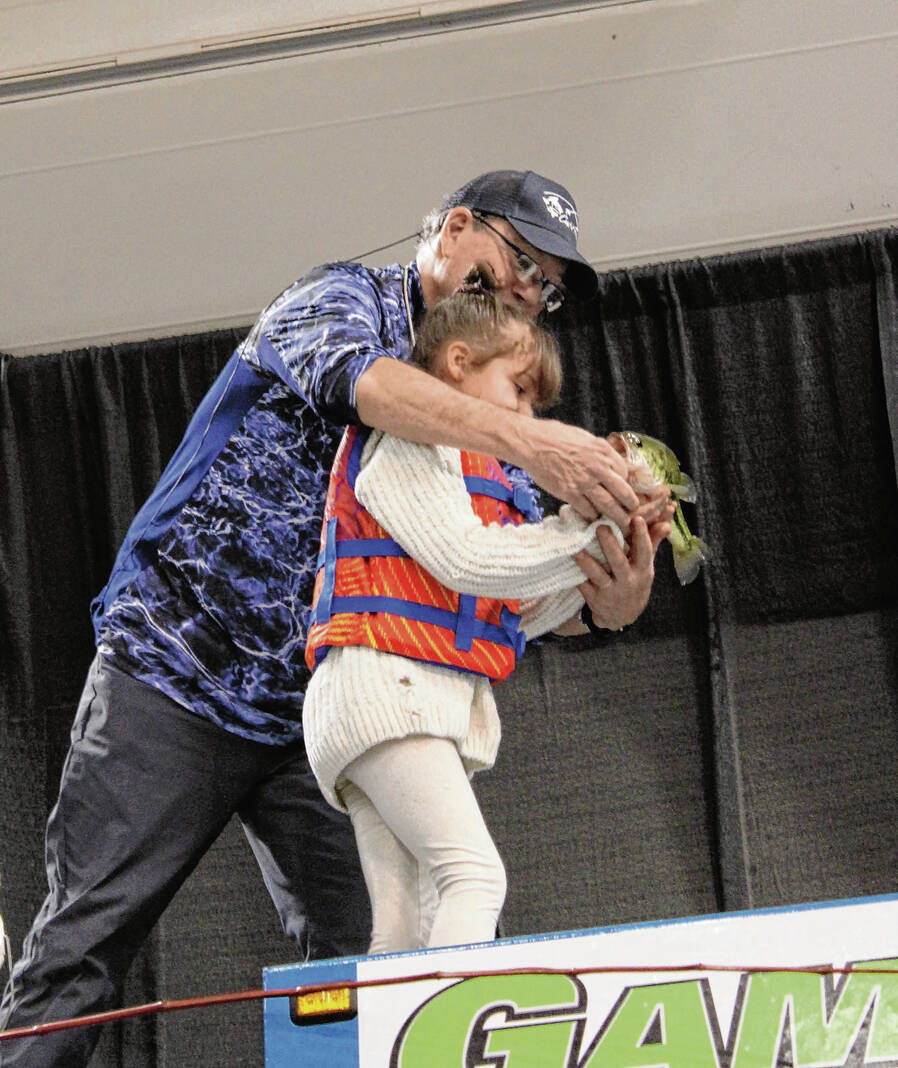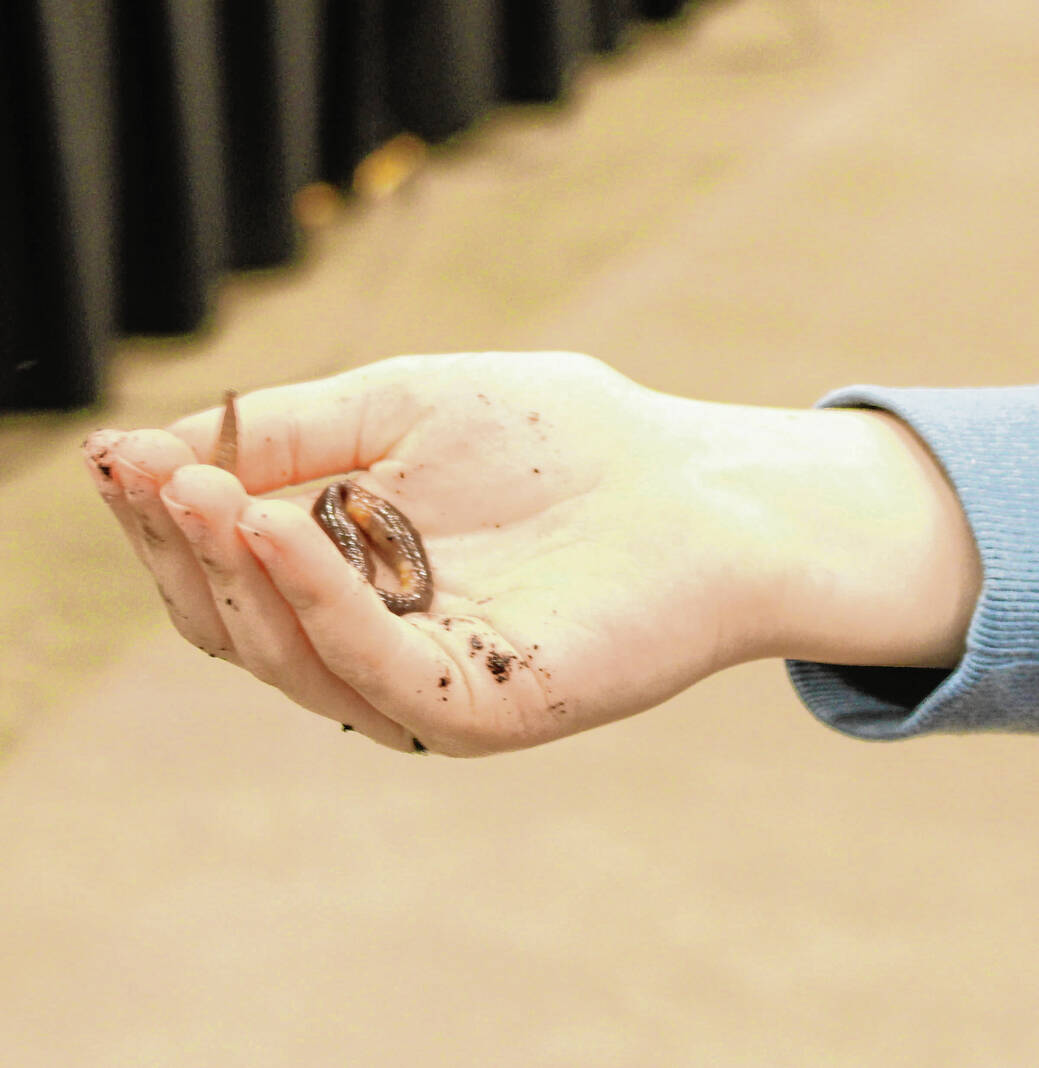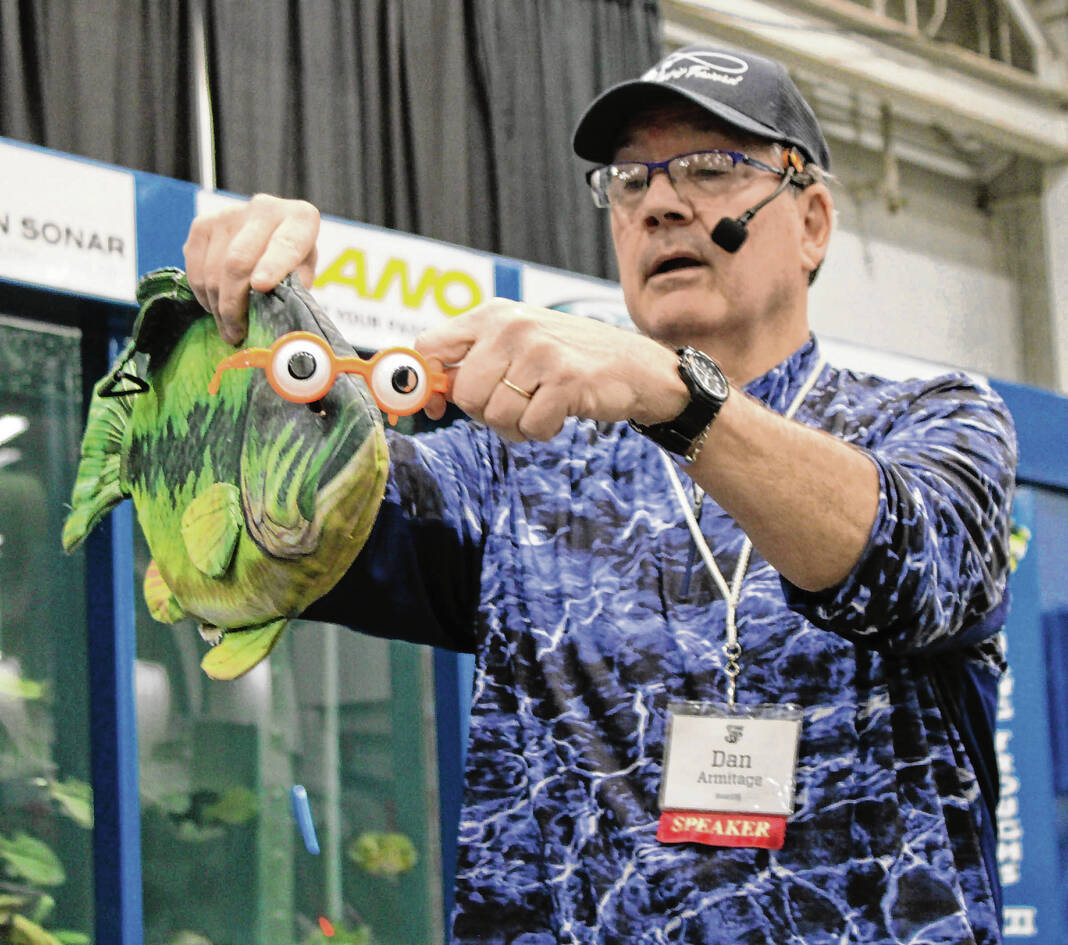
Kids fishing instructor Dan Armitage gave away bobbers to kids to help get them interested in Indiana fishing.
Lew Freedman | The Tribune

Kids fishing instructor Dan Armitage shows 8-year-old Jaya from Indianapolis how to handle a largemouth bass she hooked at the Indianapolis Boat, Sport and Travel Show during his presentation.
Lew Freedman | The Tribune

Some kids were not at all squeamish about holding live worms as examples of fishing bait.
Lew Freedman | The Tribune

Using props such as a stuffed fish and toy sunglasses, Dan Armitage seeks to hold youngsters’ attention during a presentation teaching kids to fish.
Lew Freedman | The Tribune
INDIANAPOLIS — Since Dan Armitage speaks to audiences with youngsters all of the time, in schools, and at forums such as the recent Indianapolis Boat, Sport and Travel Show, he hears all types of pronouncements from the mouths of babes.
He is an adherent of the philosophy espoused by one-time TV star Art Linkletter, who famously declared many years ago “kids say the darnedest things.”
They still do. Armitage is an outdoor and travel writer, and an enthusiastic angler, who is a proselytizer for teaching kids how to fish, both as a way to generate interest in the outdoors by younger generations and to add fresh faces to the hobby.
When Armitage makes these presentations, he takes the regular risk of being flummoxed by answers given from kids from ages whatever to whatever, maybe three years old to 12.
He may be an earnest listener, but sometimes he blinks and laughs while trying to keep his information flow going while perhaps in the same manner elementary school teachers are caught off guard.
As he sought to illustrate that fish do not like direct sunlight by holding up a stuffed fish wearing colorful, toy-like sunglasses, he asked the gathering of about 30 kids accompanied by parents what they do to combat that kind of brightness.
“Hide,” declared one boy about 10 years old.
“Tell, your parents,” Armitage responded swiftly, “so they don’t think you ran away and joined the circus.”
Armitage has lectured in this manner for many years, appearing at the Indy show before, and come March has a book being released called “Let’s Learn to Fish” aimed at the young age group.
One of the first questions Armitage posed was asking kids to raise their hands if they had ever been fishing. Something north of 20 hands shot into the air.
“I love the Indianapolis show,” Armitage said.
Before he even began talking, Armitage tossed small gifts to each child. His carrying case was a basketball-sized super red-and-white bobber and if some thought he was dishing out candy that was not true. Armitage was giving away normal-sized bobbers for the kids to keep and hopefully use while fishing.
His series of questions did not match the SAT in degree of difficulty, but Armitage asked the kids to list things necessary to go fishing. Assuming a tactical stance not so different from a teacher threatening to banish a rules violator to the corner, he informed them if they talked out of turn, he would dump them into the extra-large fish tanks on display at the edge of the stage. No one had to swim for his life.
Some essentials: Fishing rod, hook, line, bobber, bait. “Yes!” Armitage replied for each correct answer, sometimes offering a high-five, too.
Importantly noted — and when it comes to terminology perhaps not all adults knew the answer — is the difference between a fishing rod and a fishing pole. The descriptions are often used interchangeably, but technically that is not accurate.
A pole is from nature, such as a bamboo fishing utensil. A rod is manmade, produced from a manufacturing company.
“You don’t need fancy tackle to catch fish,” Armitage said.
Demonstrating that point, Armitage told a story about a visit he took to Puerto Rico. He wandered to a dock near his hotel and cast into the water, catching nothing. Nearby, a group of youngsters were slaying fish repeatedly. He watched them employ their system by tag team. One person collected discarded water bottles with sea water inside, another scooped up minnows and kept them alive in the bottles and another gathered discarded lines. They proceeded to catch grouper and snapper in abundance.
These young people were fishing for food and showed through ingenuity and cooperation, the simplest equipment could be used to catch fish.
Armitage told his listeners they did not have to be restricted if they didn’t have any minnows for bait. He passed out some worms, which the kids did not seem to consider to be yucky as they held them in their hands. But wait, there was more.
“Just because you don’t have traditional bait doesn’t mean you don’t have bait,” Armitage said.
He mashed down part of a hot dog bun, split it in two and proceeded to toss the ends into fish tanks where bass and crappie dashed for the treats. Armitage reached into his pocket and parted with one of his own treats, Dots, the candy. Flipping a red one into another tank, it set of another scramble, pretty much showing fish will eat about anything.
Armitage then volunteered a volunteer, Jaya, 8, of Indianapolis to climb a ladder and stand next to him above the very tall fish tanks — and fish. Jaya had been a whiz at answering questions throughout and this was a reward.
Sure enough, she quickly caught a fish under Armitage’s guidance. It was a largemouth bass of worthy size. Yet for all of her enthusiasm, Jaya indicated she isn’t ready for the BASS tour — she didn’t want to touch the fish.
